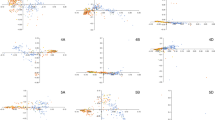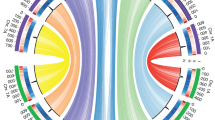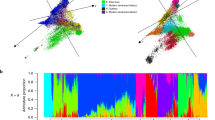Abstract
We have compared the structure of the genomes of rice and hexaploid bread wheat, which speciated more than 60 million years ago, by reciprocal mapping of DNA probes. Results indicate that many wheat chromosomes contain homoeologous genes and genomk DNA fragments in a similar order to that found on rice chromosomes. This conservation of gene order along chromosomes differing in DNA content by some 30–fold, may provide a basis for novel gene isolation strategies in wheat, one of the world's major food crop species.
This is a preview of subscription content, access via your institution
Access options
Subscribe to this journal
Receive 12 print issues and online access
$209.00 per year
only $17.42 per issue
Buy this article
- Purchase on Springer Link
- Instant access to full article PDF
Prices may be subject to local taxes which are calculated during checkout
Similar content being viewed by others
References
Wolf, K.H., Gouy, M., Yang, Y.-W., Sharp, P.M. and Li, W.H. 1989. Date of the monocot-dicot divergence estimated from chloroplast DNA sequence data. Proc. Natl. Acad. Sci. USA 86: 6201–6205.
Martin, W., Gierl, A. and Saedler, H. 1989. Molecular evidence for precietaceous angiosperms origins. Nature 339: 46–48.
O'Brien, S.J. and Graves, J.A.M. 1990. Report of the committee on comparative gene mapping. Cyto. Cell. Genet. 55: 406–433.
Maccarone, P., Watson, J.M., Francis, D., Selwood, L., Kola, I. and Graves, J.A.M. 1992. The evolution of human chromosome 21: Evidence from in situ hybridisation in Marsupials and a Monotreme. Genomics 13: 1119–1124.
Devos, K.M., Millan, T. and Gale, M.D. 1993. Comparative RFLP maps of homoeologous chromosomes of wheat, rye and barley. Theor. Appl. Genet. 85: 784–792.
Bonierbale, M., Plaisted, R.L. and Tanksley, S.D. 1988. RFLP maps based on a common set of clones reveal modes of chromosomal evolution in potato and tomato. Genetics 120: 1095–1103.
Whitkus, R., Doebley, J. and Lee, M. 1992. Comparative genome mapping of sorghum and maize. Genetics 132: 1119–1130.
Ahn, S. and Tanksley, S.D. 1993. Comparative linkage maps of the rice and maize genomes. Proc. Natl. Acad. Sci. USA. 90: 7980–7984.
Tanksley, S.D., Bernatzky, R., Lapitan, N.L. and Prince, J.P. 1988. Conservation of gene repertoire but not gene order in pepper and tomato. Proc. Natl. Acad. Sci. USA. 85: 6419–6423.
Devos, K.M. and Gale, M.D. 1992. The genetic maps of wheat and their potential in plant breeding. Outlook on Agriculture 22: 93–99.
Moore, G., Abbo, S., Cheung, W., Foote, T. et al. 1993. Key features of cereal genome organisation as revealed by the use of cytosine methylation-sensitive restriction endonucleases. Genomics 15: 472–482.
Saito, A., Yano, M., Kishimoto, N., Nakagahra, M. et al. 1991. Linkage map of restriction fragment length polymorphism loci in rice. Japn. J. Breeding 41: 665–670.
Tanksley, S.D., Causse, M., Fulton, T., Ann, N. et al. 1992. A high density molecular map of the rice genome. Rice Genet. Newsl. 9: 111–115.
Nagamura, Y., 1993. Rice Genome 2(1), (ed: Minobe, Y.) 3 and 11-13.
Kinoshita, T. 1990. Report of the Committee on Gene Symbolization Nomenclature and Linkage Groups. Rice Genet. Newsl. 7: 16–50.
Hart, G.E., Gale, M.D. and Mclntosh, R.A. 1993. Triticum aestivum and T. tauschii (wheat), p. 6.204–6.219. In: Genetic Maps. Locus Maps of Complex Genomes, 6th Ed. (O'Brien, S. J.) (Ed.). Cold Spring Harbor Laboratory Press, NY.
Devos, K.M., Chinoy, C.N., Atkinson, M.D., Hansen, L., Wettstein-Knowles, P., von and Gale, M.D. 1991. Chromosomal location in wheat of the genes coding for the acyl carrier proteins I and III. Theor. Appl. Genet. 82: 3–5.
Moore, G., Gale, M.D., Kurata, N. and Flavell, R. B. 1993. Molecular analysis of small grain cereal genomes—Current status and prospects. Bio/Technology 11: 584–589.
Devos, K.M., Atkinson, M.D., Chinoy, C.N., Liu, C.J. and Gale, M.D. 1992. Chromosomal rearrangements in rye genome relative to that of wheat. Theor. Appl. Genet. 83: 931–939.
Sears, E.R. 1954. The aneuploids of common wheat. Missouri Agricultural Experimental Station. Res. Bull. 572: 1–59.
Lander, E.S., Green, P., Abrahamson, J., Barlow, A., Daly, M.J., Lincoln, S.E. and Newburg, L., 1987. Mapmaker. An interactive computer package for constructing primary genetic linkage maps of experimental and natural populations. Genomics 1: 174–181.
Author information
Authors and Affiliations
Rights and permissions
About this article
Cite this article
Kurata, N., Moore, G., Nagamura, Y. et al. Conservation of Genome Structure Between Rice and Wheat. Nat Biotechnol 12, 276–278 (1994). https://doi.org/10.1038/nbt0394-276
Received:
Accepted:
Issue Date:
DOI: https://doi.org/10.1038/nbt0394-276
This article is cited by
-
Cloning, characterization of TaGS3 and identification of allelic variation associated with kernel traits in wheat (Triticum aestivum L.)
BMC Genetics (2019)
-
Genome-wide identification and expression profiling of glutathione transferase gene family under multiple stresses and hormone treatments in wheat (Triticum aestivum L.)
BMC Genomics (2019)
-
Cross-taxon transferability of sugarcane expressed sequence tags derived microsatellite (EST-SSR) markers across the related cereal grasses
Journal of Plant Biochemistry and Biotechnology (2019)
-
Utilization of a Wheat660K SNP array-derived high-density genetic map for high-resolution mapping of a major QTL for kernel number
Scientific Reports (2017)
-
Identification of candidate genes, regions and markers for pre-harvest sprouting resistance in wheat (Triticum aestivum L.)
BMC Plant Biology (2014)



